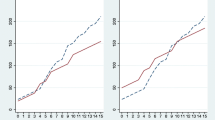Abstract
Traditional analyses of bonuses have focused on performance measures such as output or profit as the sole determinant of bonus pay plans. However, com-panies now use bonuses for a variety of purposes, including employee recruit-ment and retention and to obtain better outcomes in quality and customer service. These trends suggest that a host of strategic considerations influence company decisions about bonus payouts, ranging from traditional concerns such as employee performance to the company’s reputation among prospective employ-ees and customers, stakeholder influence, and support for technological and organizational change as part of company plans to develop intangible assets. Using data from 2000 ELCS (European Labor Cost Survey), I investigate the determinants of bonus payouts, in particular how a company’s concerns about intangible assets affect its bonus outlays. Consistent with a growing body of evidence, both individual and workplace effects are important in explaining the variation in the incidence of bonus payments. Specifically, the findings suggest that human capital investments are positively related to bonus payments.
Similar content being viewed by others
References
Acemoglu, Daron. “Why Do New Technologies Complement Skills? Directed Technical Change and Wage Inequality.” Quarterly Journal of Economics 113 (November 1998): 1055–90.
Benabou, Roland. “Equity and Efficiency in Human Capital Investment: The Local Connection.” Review of Economic Studies 63 (April 1996): 237–64.
Brignall, Stan. “A Contingent Rationale for Cost System Design in Services.” Management Accounting Research8(September 1997): 325–46.
Bureau of Labor Statistics. National Compensation Survey. Washington, DC: U.S. Bureau of Labor Statistics, 2002.
Cable, John and Nicholas Wilson. “Profit Sharing and Productivity: Some Further Evidence.” Economic Journal 99 (June 1989): 550–55.
Cappelli, Peter and David Neumark. “Do ‘High-Performance’ Work Practices Improve Establishment-Level Outcomes?” Industrial and Labor Relations Review 54 (July 2001): 737–75.
Cully, Mark. Britain at Work: As Depicted by 1998 Workplace Employee Relations Survey. New York: Routledge, 1999.
Doeringer, Peter and Michael Piore. Internal Labor Markets and Manpower Analysis. Lexington, MA: D.C. Heath, 1971.
Estrin, Saul and N. Wilson. “The Micro-economic Effects of Profit Sharing.” London: Centre for Labor Economics, Paper No. 864, 1986.
Fernie, Sue and David Metcalf. “Participation, Contingent Pay, Representation and Workplace Performance: Evidence from Great Britain.” British Journal of Industrial Relations 33 (September 1995): 379–415.
Fitzroy, Felix and Kornelius Kraft. “Co-operation, Productivity and Profit Sharing.” Quarterly Journal of Economics 102 (February 1987): 23–35.
Freeman, David. “The Impact of Bonus Payments on the Average Earnings Index.” Labor Market Trends 110/12 (December 2002): 667–71.
Freeman, Richard and Edward Lazear. “An Economic Analysis of Works Councils.” In J. Rogers et al., eds. Works Councils: Consultation, Representation and Cooperation in Industrial Relations. Chicago: University of Chicago Press, 1995.
Galor, Oded and Omer Moav. “From Physical to Human Capital Accumulation: Inequality and the Process of Development.” Review of Economic Studies 71 (October 2004): 1001–26.
Ichniowski, Casey, Kathryn Shaw, and Giovanna Premushi. “The Effects of Human Resource Management Practices on Productivity: A Study of Steel Finishing Lines.” American Economic Review 87 (June 1997): 291–313.
Incomes Data Services. Bonus Schemes. London: IDS HR Study No 742, 2003.
Joshi, Heather and Pierella Paci. Unequal Pay for Men and Women. Cambridge, MA: MIT Press, 1998.
Kaplan, Robert and David Norton. The Balanced Scorecard—Translating Strategy into Action. Boston, MA: Harvard University Press, 1996.
Kandel, Eugene and Edward Lazear, “Peer Pressure and Partnerships.” Journal of Political Economy 100 (August 1992): 801–17.
Kruse, Douglas. Profit Sharing: Does It Make a Difference? Kalamazoo, MI: Upjohn Institute, 1993.
Lazear, Edward. Personnel Economics for Managers. New York: Wiley, 1998.
Lev, Baruch and Paul Zarowin. “The Boundaries of Financial Reporting and How to Extend Them.” Journal of Accounting Research 37 (Autumn 1999): 353–85.
MacDuffie, John. “Human Resource Bundles and Manufacturing Performance: Organizational Logic and Flexible Production Systems in the World Auto Industry.” Industrial and Labor Relations Review 48 (January 1995): 197–221.
Milgrom, Paul and John Roberts. “Complementarities and Fit: Strategy, Structure, and Organizational Change in Manufacturing.” Journal of Accounting and Economics 19 (March-May 1995): 179–208.
Nisar, Tahir M. “Is It All in the Timing? The Practice of Bonus Payments in the UK.” Compensation and Benefits Review 35 (September/October 2003): 31–40.
Osterman, Paul. “How Common Is Workplace Transformation and Who Adopts It.” Industrial and Labor Relations Review 47 (January 1994): 173–88.
Poole, Michael and Keith Whitfield. “Theories and Evidence on the Growth and Distribution of Profit Sharing and Employee Shareholding Schemes.” Human Systems Management 13 (April 1994): 209–20.
Roberts, John and Eric Van den Steen. Shareholder Interests, Human Capital Investment and Corporate Governance. Stanford, CA: Graduate School of Business, Stanford University, Research Paper No. 1631,2000.
Ulrich, Dave and Norm Smallwood. “Capitalizing on Capabilities.” Harvard Business Review 82 (June 2004): 119–27.
Weitzman, Martin and Douglas Kruse. “Profit sharing and Productivity.” In Alan Blinder, ed. Paying for Productivity: A Look at the Evidence. Washington, DC: Brookings Institution, 1990, pp. 95–141.
Wood, Stephen. The Transformation of Work? Skill Flexibility and the Labor Process. London: Unwin, 1989.
Author information
Authors and Affiliations
Rights and permissions
About this article
Cite this article
Nisar, T.M. Bonuses and investment in intangibles. J Labor Res 27, 381–395 (2006). https://doi.org/10.1007/s12122-006-1029-5
Issue Date:
DOI: https://doi.org/10.1007/s12122-006-1029-5



